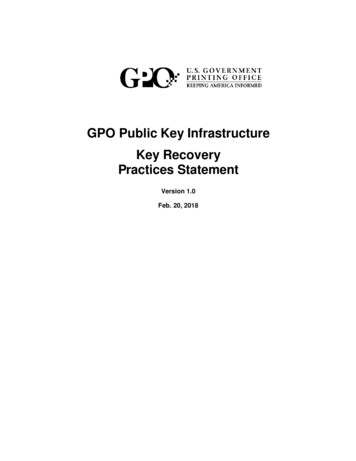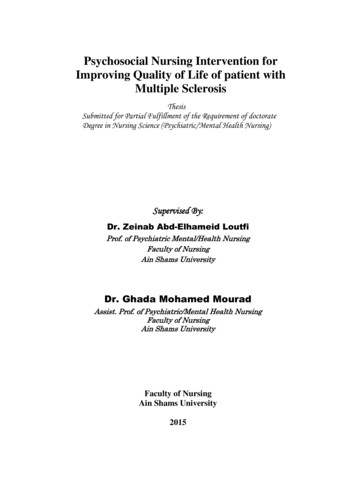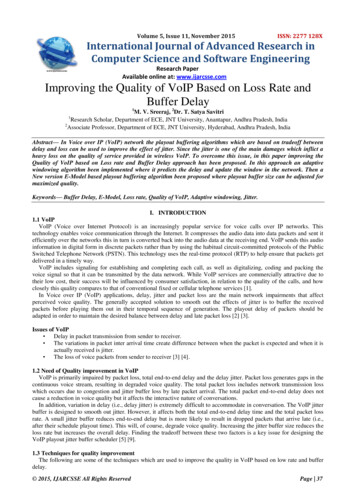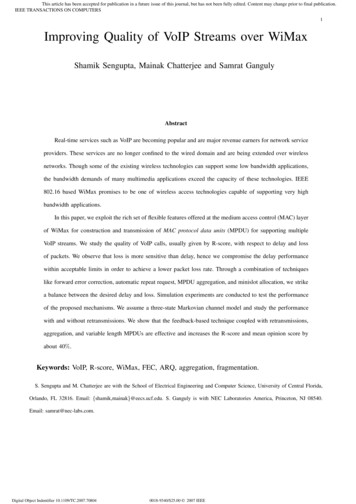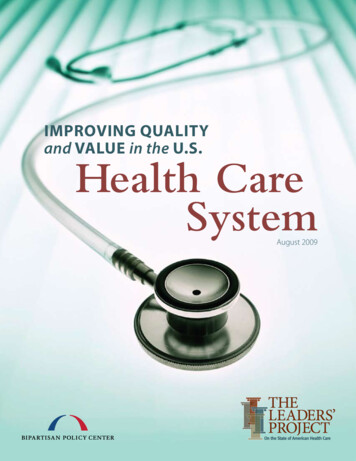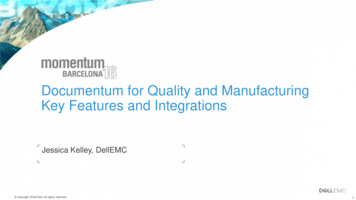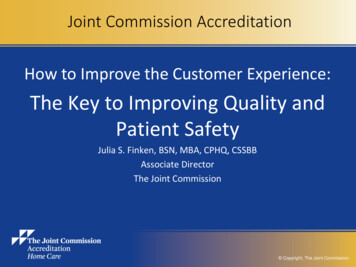
Transcription
Joint Commission AccreditationHow to Improve the Customer Experience:The Key to Improving Quality andPatient SafetyJulia S. Finken, BSN, MBA, CPHQ, CSSBBAssociate DirectorThe Joint Commission Copyright, The Joint Commission
GoToWebinar HousekeepingYour ParticipationJoin audio: Choose “Mic & Speakers” to useVoIP Choose “Telephone” and dial usingthe information providedQuestions/Comments: Submit questions and comments viathe Questions panel.Note: Today’s presentation is beingrecorded and will be posted on theJoint Commission website.2
Joint Commission AccreditationHow to Improve the Customer Experience:The Key to Improving Quality andPatient SafetyJulia S. Finken, BSN, MBA, CPHQ, CSSBBAssociate DirectorThe Joint Commission Copyright, The Joint Commission
Objectives Identify 3 Key Components of an ExceptionalCustomer Experience Describe the Link Between a Superior CustomerExperience and Quality and Patient Safety Name 3 Key Tools Utilized to Improve the CustomerExperience4
The Link Between a Superior Customer Experienceand Quality and Patient Safety Superior Customer Experience ads to Improved Quality of Care and Patient Safety Identification of early warning signsCompliance with treatment regimen and safety measuresMore effective assessmentsMore effective plans of careOther5
Why Patient Perception of Care Matters Improved Clinical Outcomes Improved Patient Safety Improved Financial Performance Improved Staff Recruitment and Retention Improved performance on publicly reportedmeasures HHCAHPS other6
Key Drivers to Improve the CustomerExperience Focus on High Reliability Zero Defect, Culture of Trust Balancing Care with maintaining Dignity and SelfDetermination Engage Patients in Care Decisions Listen to and Act on the Voice of the Customer Compassionate Care Efficient and Effective Systems Implemented with a Smile Eliminate Waste and Focus on Value Added Services7
Role of Culture and Strategy inImproving the Customer Experience Culture Eats Strategy for Lunch but both areCritical8
Create a Culture of Safety and Quality Leaders create this culture by fostering: Team workOpen CommunicationOngoing LearningA Focus on Systems and Processes All team members focus on maintainingexcellence in performance to deliver safe, highquality care, supported by key performanceexcellence systems.9
Transforming the Patient Experience Service Assessment Leadership Commitment Service Protocols Constant Focus on Service Protocols Performance Accountability Recognize/Reward10
Linkage Between Employee Satisfactionand Patient Satisfaction in Home Care Organizational commitment to patient care andcustomer service are fundamental to patientsatisfaction. The more employees perceive that the organization isfocused on quality and customers, the more patientsatisfaction increases. Work-life balance, fair compensation, and regard foremployees all influences patient satisfaction.11
Patient Satisfaction and the Health Care Journey What reduced satisfaction was something fewcompanies manage—cumulative experiencesacross multiple touchpoints and in multiplechannels over time. More Touchpoints – More Complexity12
Patient Loyalty Loyal Patients High Confidence in Provider High Worked Together High Concerns for Worries Non-Loyal Patients Low Confidence in ProviderLow Worked TogetherLow CourtesyLow Listens Carefully13
Effective Strategies to Engage Leadersin the Patient Experience Create a Framework for Success Senior leadership, including leaders at the C-suite level, mustcreate a foundation on which the patient experience at theirorganizations can flourish. Leaders must: Create focus and define the strategy. Get crystal clear on the current reality. Raise service awareness Promote consistent service delivery. Engage in service recovery Define the senior leader’s role. Define the director and manager roles.14
Effective Strategies to Engage Staffand Change Behavior Planning Communication Expectations Accountability Using Data Changing Performance The Power of Transparency Staffing15
The Chicken or the Egg? Improved Employee Satisfaction Drives ImprovedPatient Satisfaction in Home Care and/or . Improved Patient Satisfaction Drives ImprovedEmployee Satisfaction in Home Care16
Effective Strategies for PatientEngagement Ask patients/families for input Act on input Ask patients/families for feedback Communicate, Communicate, Communicate Open Notes Initiative Establish and maintain a relationship withdemonstrated respect, empathy, trust, skill Determine shared/complementary Goals17
Patient Advisory Council Integrated into Advisory Board or separate Be sure it is interactive and information and advice isobtained from Patients Make sure to obtain feedback on patient’sexpectations Include Patient Advocates and Care Managers asrepresentatives of patients Be sure to provide council with actions taken based ontheir input18
Caregivers Perception of Care andEngagement Matters Caregiver may be the Primary Consumer of yourServices Engage the Caregiver as you would Engage thePatient Caregiver Needs May Be in Excess to PatientNeeds19
Improvement in Clinical Care Leads toImprove Patient Perception of Care Pain Management Improvement in Functional Status* Social Interaction Pet Therapy Respectful Treatment Ask “What can I do to improve your care?”20
Effective Pain Management and the Improvementsin Patient Outcomes and Satisfaction Overall increase in HCAHPS Patient Satisfaction Scorewith improvement in pain management VBP-Patients more likely to be dissatisfied if lack ofvalidation or negative clinician attitudes regardingpatient pain experience Effective Strategies Effective analgesics Interdisciplinary Practice Evidence Based Approach21
Always Events Always Events are aspects of the patient experiencethat are so important to patients and families thathealthcare providers must perform themconsistently for every patient, every time. Important Evidenced Based Measurable Affordable and Sustainable22
The Little Things Matter Informing Patients/Families of the Schedule Continuity of Staff Asking for Input/Feedback Arriving on Time Respecting Patient’s Environment Explaining Care Asking for Permission Saying Thank You23
The Imperative of HealthcareCommunication: A Relationship Model The Impact of Communication on the PatientPerception of Care and Quality Outcomes Relationship Centered Communication Relationship Establishment Relationship Development Relationship Engagement24
Impact of Technology on the Patient’sPerception of Care Affords more frequent interaction at a lower cost Can be seen by patient as “cold” contact-takemitigating actions Enhances provider communication, coordinationof care, and transitions of care25
Finding the Heart of Healthcare Compassionate Care Patient Perception of Caring Behaviors Professional Knowledge and Skill Responding when needed and without being prompted Doing extra little things Following Through Taking Care of Patient Needs Nurse Perception of Caring Behaviors Teaching Listening Supporting26
Compassion Improves Quality of Careand Bottom Line Compassion and Competence-the customer desiresand deserves both27
Case Study: Cleveland Clinic Identifying the Opportunity Leading the Change Publicly Acknowledging the Problem Understanding Patient Needs Making Everyone a Caregiver Embedding Changes Setting Patients Expectations28
Performance Improvement Tool Box toImprove the Customer Experience29
Roles in Team Activities30
DMAIC31
Define Define the problem and identify opportunities forImprovement Goals Scope Business Case Specify what customers value32
Critical PathKey Questions and Key RPI Tools Key QuestionsWhat is the problem?Why is it important?Who is the customer?What is the project scope?What does the customer want?What is critical to quality? What is the goal?What are you going to improve?By how much are you going to improve it?By when are you going to improve it?Who are your key stakeholders?Who will be on the project teamWhat is the project time line?What does the current state look like?RPI Tools15 Words; CharterThreats and Opportunities; 3D;CharterIncludes/Excludes; CharterVoice of Customer; Critical toQuality; Quality FunctionDeployment; Survey Design; KanoModelSMART; More Of/Less Of; CharterSMART; CharterARMI; CharterWWW; CharterSIPOC Process Map33
Tips to Avoid Potential Pitfalls Narrow problem/opportunity definition Clear project scope (includes/excludes) Broad definition of customers/stakeholders Inclusive project team ( 10) Champion/Detractor Measurable Goal Defined Team Member Roles34
HHCAHPS: National DatawvwHHCAHPS NATIONAL Would patients recommendthe home health agency tofriends and family79Nation32How often the home healthteam gave care in aprofessional way88Nation35How do patients rate theoverall care from the homehealth agency84Nation33How well did the home healthteam communicate withpatients85Nation34Did the home health teamdiscuss medicines, pain, andhome safety with patients8435
HHCAHPS: State Data State DatawwwHHCAHPS STATE OUTCMStateMeasureIDMeasureDescPercentageMD33How well did the home healthteam communicate withpatients85MD32How often the home healthteam gave care in aprofessional way87MD36Would patients recommendthe home health agency tofriends and family76MD35How do patients rate theoverall care from the homehealth agency82MD34Did the home health teamdiscuss medicines, pain, andhome safety with patients8236
HHCAHPS: Agency DatavwHHCAHPS MSR PRVDR 3How well did the home healthteam communicate withpatients77XYZ32How often the home healthteam gave care in aprofessional way79XYZ36Would patients recommendthe home health agency tofriends and family72XYZ35How do patients rate theoverall care from the homehealth agency82XYZ34Did the home health teamdiscuss medicines, pain, andhome safety with patients8237
Example CharterXYZ Home CarePerformance Improvement Project CharterImprovement in HHCAHPS Score: Communication Between Providers and PatientsI.Project Mission: To improve the agency HHCAHPS score for “How well did the home health teamcommunicate with patients?”II.Reason for Action: There is an opportunity to improve the agency HHCAHPS score for “How well did thehome health team communicate with patients?” The agency’s score is below both the National and State scores.III.Sponsors:a.Susie Smith, Administratorb.Tom Marcus, Medical DirectorIV.Team Leader:a.Tim Turner, RPTV.Team Facilitator:a.Barbara TennysonVI.Scribe:a.Marc Jacobs, MSWVII.Timekeeper/Process Checkera.Julie AbbottVIII.Team Members:a.John Jones, MDb.Carol Thomason, DOPCSc.Wendy Cluggr, RNd.Tim Turner, RPTe.Maggie Franklin, CHHAf.Paul Pierce, STg.Julie Abbott, Schedulerh.Tina Boyle, OTi.Marc Jacobs, MSWj.Laura Evans, Supervisork.Jesse Mohr, Team Assistantl.Robert Cordara, LVNIX.Meeting Frequency, Interval and Duration:a.Meet Q.O.W x 10 meetingsb.Meeting length of 90 minutesX.Meeting Location:a.Meeting Location is XYZ Home Care, Conference Room 100XI.Project Deliverables:a.The agency HHCAHPS score for “How well did the home health team communicate with patients?” willincrease from 77 to 81 by March 31, 2016.XII.Measures:a.Agency HHCAHPS score for “How well did the home health team communicate with patients?” 81XIII.Reporting:a.The Team Leader will report to the Administrator and Medical Director at least monthly and as needed orrequested.38
Charter Mission and Reason for Action Project Mission: To improve the agency HHCAHPSscore for “How well did the home health teamcommunicate with patients?” Reason for Action: There is an opportunity toimprove the agency HHCAHPS score for “How welldid the home health team communicate withpatients?” The agency’s score is below both theNational and State scores.39
Team Sponsors: Susie Smith, Administrator Tom Marcus, Medical Director Team Leader: Tim Turner, RPT Team Facilitator: Barbara Tennyson Scribe: Marc Jacobs, RN Timekeeper/Process Checker Julie Abbott Team Members: John Jones, MD Carol Thomason, DOPCS Wendy Clugger, RN Tim Turner, RPT Maggie Franklin, CHHA Paul Pierce, ST Julie Abbott, Scheduler Tina Boyle, OT Marc Jacobs, MSW Laura Evans, Supervisor Jesse Mohr, Team Assistant Robert Cordara, LVN40
Logistics Meeting Frequency, Interval and Duration: Meet Q.O.W x 10 meetings Meeting length of 90 minutes Meeting Location: Meeting Location is XYZ Home Care, Conference Room 100 Project Deliverables: The agency HHCAHPS score for “How well did the home health teamcommunicate with patients?” will increase from 77 to 81 by March 31,2016. Measures: Agency HHCAHPS score for “How well did the home health teamcommunicate with patients?” 81 Reporting: The Team Leader will report to the Administrator and Medical Director atleast monthly and as needed or requested.41
Example ARMIRole in Project PhaseKey StakeholdersAdministratorMedical TPTAOTACHHAMSWVP onAAMRRMMMIMIIRIIRMMEvaluationAAMIIMMIIMIIMIIMMM42
Measure Determine current performance level (baseline)and the capability of the process to meet customerexpectations. Identify all steps and inputs in the value stream Identify potential causes and drivers Gather and qualify the data43
Key Questions and Key RPI ToolsQuality Critical PathRPI ToolsCause and Effect MatrixProcess Failure Mode and EffectsAnalysisData Collection Plan;Measurement System Analysis How are you going to communicate your progress tokey stakeholders?ToolsStatistical Process Control Chart;Process CapabilityDashboard; CommunicationPlan; Stakeholder Analysis Where should you focus change managementefforts?Change Management Profile;Stakeholder Analysis Key QuestionsWhat is the complete flow of your process?What areas should be focused on?What could go wrong within your focus areas?What are the probable causes for this?ToolsValue Stream Map; SpaghettiDiagram; Gamba WalkProcess Failure Mode and EffectsAnalysis Can your process meet customer demand?Takt Time What are you going to measure?How are you going to measure it?How accurate and reliable is the data?Data Collection Plan;Measurement System Analysis ProductivityKey QuestionsWhat inputs have the biggest effect on the thingsthat are critical to quality for the customer?What could go wrong with these key inputs?What are the probable causes for this?What are you going to measure?How are you going to measure it?How accurate and reliable is the data?Key QuestionsWhat is your baseline performance?44
Tips to Avoid Potential Pitfalls Gather comprehensive information regarding theprocess (Team, Sensing Sessions, VOC, other) What steps have value and where are thebottlenecks Establish baseline performance Data definition includes what, how, when Best Data not Perfect Data Communicate45
HHCAHPS Baseline Comparative DataHHCAHPS Baseline Data1009590858075Percentage7065605550Would patientsrecommend thehome healthagency to friendsand familyHow often thehome healthteam gave care ina professionalwayHow do patientsrate the overallcare from thehome healthagencyHow well did thehome healthteamcommunicatewith patientsDid the homehealth teamdiscussmedicines, pain,and home safetywith patients3632353334HHCAPS : Baseline Data Agency Percentage7279827782HHCAPS : Baseline Data State Percentage7687828582HHCAPS : Baseline Data National Percentage7988848584Score46
HHCAHPS Composite Data Drill Down Care of Patients Q19: How often did home health providers from this agency treatyou with courtesy and respect? 70 Communications Between Providers and Patients – Q15: How often did the home health providers from this agencykeep you informed about when they would arrive at your home?69 Q17 How often did home health providers from this agency explainthings in a way that was easy to understand? 71 Q18: How often did home health providers from this agency listencarefully to you? 6847
Brainstorm: Behaviors That DemonstrateActive Listening Smile Eye Contact Posture (lean in or tilt) Mirroring Attentive Positive Reinforcement Remembering Questioning Reflection Summarization48
Voice of the Customer Obtain feedback from the Customer regarding whatBehaviors have the most impact in conveying thatstaff are listening carefully to the customer Survey49
Example Data Collection PlanPerformanceMeasuresListen Carefully 90OperationalDefinitionData Sourceand LocationSample SizeHow often didhome healthproviderslistencarefully areful(Active)ListeningN 50Surveys:PurposiveSampling,betweendates of9/1/15through9/30/15Who WillCollect theDataPI TeamMembersWhere willData beCollectedHome VisitsHow will Data BeCollectedOther Data thatShould be Collectedat the Same TimeIPAD Survey atcompletion ofthe Home VisitDisciplineEmployee NameYears with agencyEmployee Age50
Analyze Use the data to investigate cause and effectrelationships, drill down potential root causes,and validate the root causes that have thegreatest impact on current performance level Identify root causes of waste, variation, anddefects Distill the data Focus on and verify root causes and drivers Quantify impacts (technical and business)51
Key Questions and Key RPI ToolsProductivityCritical PathQuality Key QuestionsWhat does the data showo Statistical Significance?o Practical Significance?RPI ToolsGraphical Tools (e.g. ParetoChart, Histogram); StatisticalTools (e.g. 2-sample t-test,Regression)Key QuestionsToolsHypothesis TestWhat are the validated root causes?How are you going to communicate your findings to Dashboard; CommunicationPlan; Stakeholder Analysiskey stakeholders?Key QuestionsWhat does the data show?o Statistical significance?o Practical Significance?ToolsGraphical Tools (e.g. ParetoChart, Histogram); StatisticalTools (e.g. 2-sample t-test,Regression)52
Tips to Avoid Potential Pitfalls Statistical Significance vs. Practical Data – AvoidParalysis Verify Root Causes Communicate Findings53
Example ParetoPareto %0FrequencyCumulative %Eye 29892%96%100%Cumulative %54
Example Communication Plan55
Example Communication PlanAudienceLeadershipMessage/GoalOverview of ProjectPI/Compliance StaffOverview of ProjectExpectationsOverview of ProjectExpectationsActionsOverview of ProjectExpectationsActionsSupervisorsProvider StaffAdministrativeSupport StaffOverview of ProjectClinical Support StaffOverview of ProjectBoardOverview of ProjectCustomersOverview of ProjectPhysiciansOverview of ere/HowMonthly LeadershipForumMonthly MeetingWhoAdministrator/Medical DirectorMarc Jacobs RN,When10/1/15Weekly SupervisorMeetingLaura ensaverLetterSpecial MeetingTim Turner, RPTMultiple letterEmailMonthly MeetingJulie Abbott,Scheduler11/21/15Monthly StaffMeetingJesse Mohr, TeamAssistant11/19/15Quarterly BoardMeetingAdministrator/Medical Director10/1/15Carol Thomason,DOPCSMedical Director11/30/15EmailLetter10/17/1511/30/1556
Communication Plan Overview of Project: Opportunity Measures Goals Findings Strategies Expectations: Attend Mandatory Education onCommunication Skills Exhibit
Objectives Identify 3 Key Components of an Exceptional Customer Experience Describe the Link Between a Su
